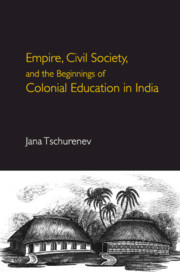Book contents
- Frontmatter
- Dedication
- Contents
- List of Figures
- List of Tables
- List of Abbreviations
- Acknowledgements
- Introduction: Empire Civil Society, and Educational Transformation in India
- 1 A Colonial Experiment in Education, Madras, 1789–1796
- 2 Education of the Poor, 1805–1813
- 3 Missionaries, Empire, and the Cause of Universal Education, 1792–1824
- 4 Race, Class, and Gender: The Social Agenda of Education, 1809–1830
- 5 Rules and Numbers: Transforming Rural Education, 1814–1830
- 6 Intellectual Conquest: Education Societies, ‘Useful Knowledge’, and the Bengal Renaissance, 1817–1854
- 7 Civil Society, Government, and Educational Institution-Building, Bombay Presidency, 1819–1882
- 8 Teaching the Marginalized: Universal Education and the Politics of Inequality, 1789–1937
- Conclusion: The Emergence of Public Elementary Schooling in an Imperial Frame
- Bibliography
- Index
5 - Rules and Numbers: Transforming Rural Education, 1814–1830
Published online by Cambridge University Press: 26 April 2019
- Frontmatter
- Dedication
- Contents
- List of Figures
- List of Tables
- List of Abbreviations
- Acknowledgements
- Introduction: Empire Civil Society, and Educational Transformation in India
- 1 A Colonial Experiment in Education, Madras, 1789–1796
- 2 Education of the Poor, 1805–1813
- 3 Missionaries, Empire, and the Cause of Universal Education, 1792–1824
- 4 Race, Class, and Gender: The Social Agenda of Education, 1809–1830
- 5 Rules and Numbers: Transforming Rural Education, 1814–1830
- 6 Intellectual Conquest: Education Societies, ‘Useful Knowledge’, and the Bengal Renaissance, 1817–1854
- 7 Civil Society, Government, and Educational Institution-Building, Bombay Presidency, 1819–1882
- 8 Teaching the Marginalized: Universal Education and the Politics of Inequality, 1789–1937
- Conclusion: The Emergence of Public Elementary Schooling in an Imperial Frame
- Bibliography
- Index
Summary
These are the orders of the Sahib, the Teachers and Children must mind and obey them.
How was the new system of instruction put into practice? In the last chapter, I talked about the missionaries’ ambition to change people's mentalities with the help of a new type of vernacular schooling. This chapter seeks to understand the processes of educational interaction and transformation in a local context. Indeed, hundreds of new-model schools were set up in the 1810s and 1820s. They attracted thousands of students, often from the same social strata which had attended the old type of the common vernacular schools. To implement the new system of instruction, the early nineteenth-century reformers pursued two strategies: First, the founding of new institutions, which were usually termed ‘native schools’, or ‘native free schools’. Most missionaries used this strategy. Second, they tried to remodel existing ‘indigenous schools’ (as they are described in the sources).The latter strategy characterized the Serampore missionaries and the Calcutta School Society (CSS). However, they were not mutually exclusive. What I want to emphasize is that the new educational technology was put into practice in a locally grown, socially embedded educational landscape. This encounter was accompanied by considerable friction and fundamentally affected the emerging colonial pedagogy.
In one sense, the functioning of the new-model schools constituted a rupture of the prevalent learning culture. They introduced a new curriculum, new learning techniques, routines, and rituals. As Nita Kumar has argued, already the school building, which became ‘the norm of the age’, was a radical break with a ‘learning and popular culture [that] has been oriented to the outside’ and the ‘continuities of the indoors and outdoors’. But there were also many continuities, starting with institutional and personal continuity if the pre-existing indigenous school, or its teacher, were integrated and employed within the new structure. There were continuities in what parents and students expected from a school and the kind of education they demanded. Finally, there were also continuities, as I will show, between the pre-colonial, indigenous mnemotechnics, and the ‘gradgrind’ memorization of ‘facts’ that marked colonial pedagogy and examination practice.
This chapter starts with an overview on the spread of the new ‘native schools’ and describes the pedagogical culture they introduced. It continues to analyse the conflicts between missionaries and Indian schoolmasters.
- Type
- Chapter
- Information
- Publisher: Cambridge University PressPrint publication year: 2019



